Readings in Humanistic Psychiatry
An Emerging Model of Mental Illness
Our basic beliefs about the causes of mental illness are tremendously important. They shape our individual interactions with mentally ill people and the programs that our society sets up to care for them. We'll argue that many of the current problems in our broken mental health system have arisen as a direct result of the model of mental illness that has been dominant for the past half century.
Many people regard the human brain as the most wondrous, intricately beautiful, stunningly complex creation on the planet. But we shouldn't forget what is telling us that. And it's also clear that people vary widely in their tolerance for neuroscience. Some readers will not have the taste for it, no matter how simply it's elaborated. So here is a brief summary of the model that will follow.
A capsule summary of the emerging model
The "chemical imbalance" model that has been used to explain mental illnesses and the actions of our psychiatric medications is now woefully outdated and inadequate. Modern neuroscience demonstrates that the major mental illnesses arise from problems with the way the brain is structured during fetal development and early childhood.
Enlargements in several key brain areas separate humans from other primates. These structures are responsible for our ability to maneuver symbols on our "inner screens". This amazing talent allows for the creation of our own personal realities, complete with emotions, motivations, and self-representations. But the neurological tasks involved with balancing competing versions of reality and deciding which emotions to attach to them are extremely complex. Mental illnesses result when those key structures aren't formed or functioning properly.
Because we've believed that mental illnesses resulted from a simple imbalance of brain chemicals we've assumed that if that balance could be restored with drugs the individual would be essentially "normal" again. That hasn't proven to be true. We're learning that a host of environmental factors affect the way that the brain is structured during its development, and the way that it's able to function during adulthood. The idea that the brains of people without mental illnesses would be working perfectly is looking farfetched too. The structures are so intricate and so new in evolutionary terms that there are countless things that can go wrong in brain development.
Changing the brain's chemistry with medications can be very useful but a comprehensive understanding of mental illness must also take into account the situation that the brain is functioning in. Psychiatric treatments of the future must consider both the internal chemical environment and the many external factors that influence the brain's development and functioning. Identifying the things that brains need to work at their best and finding new ways to provide them for our patients will replace the search for some magic pill that will correct those "imbalances" once and for all.
For the brave few that are willing to look at the Emerging Model of Mental Illness in greater detail here's what you'll be up against:
- 1) Limitations of the chemical imbalance model
- 2) How are we different from our primate relatives?
- 3)The process of reality construction
- 4) Balanced brain systems
- 5) The almond and the seahorse ( A dual emotional processor hypothesis )
- 6) Misconnections between thought and emotion
- 7) Is anatomy truly destiny?
Limitations of the "Chemical Imbalance" model of mental illness
Since at least the 1960's we psychiatrists have explained mental illnesses and the actions of our medications by saying that mentally ill people have a chemical imbalance in their brains, one that is corrected by taking the psychiatric drugs that we prescribe. This has been very handy for us, especially since none of us can actually describe exactly what chemicals are out of balance in any particular mental illness.
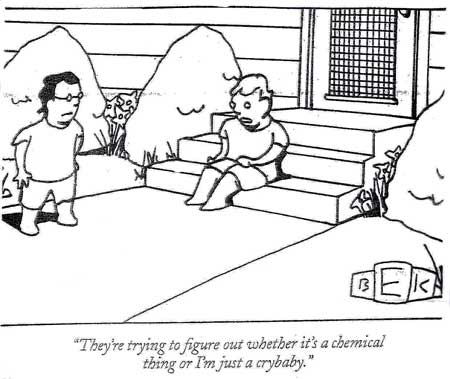
It's hard to find anyone suffering from a severe mental illness who hasn't been told that their disorder is somehow akin to diabetes, with the same requirement for a lifetime of daily medications to keep those rogue chemicals in balance. The Chemical Imbalance model has become such a pervasive part of our culture that few mental health professionals even question it. But there are a few problems with this approach.
At this time we still haven't been able to identify a specific imbalance of brain chemicals that causes any of our major mental illnesses. Our original ideas about the role of important chemical messengers such as dopamine or serotonin have proven to be simplistic and naive. The idea that an excess or deficiency of one of these neurotransmitters would be at the root of a mental illness is very appealing but it would be hard to find a serious neuroscientist who believes this anymore.
Then there's that matter of how patients respond to our attempts to correct their "imbalances". It's extremely rare to see anyone truly recover from a mental illness as a result of taking medications alone, even in the dizzying combinations that we now prescribe them in. Many people stop taking these pills at the first opportunity. The fact that we now treat essentially all of the major mental illnesses with the same combinations of antidepressants, antipsychotics, and mood stabilizers further weakens the "One mental illness- one neurotransmitter imbalance - one corrective medication" model of psychiatric treatment.
Ultimately, the biggest problem with the chemical imbalance theory was not just that it was wrong. Our models of mental illness are constantly evolving and will always contain inaccuracies. At their best, these models are only crude metaphors that we use to try to understand something that is just too complex for our little brains to grasp.
In the last analysis our models of the mind must be judged by their usefulness. As we look at the way mentally ill people are treated in our society it's hard to argue that our past models have served us well.
We've assumed that if people would just cooperate with our treatments they'd be back to normal in no time. That's translated into an expectation that they'd willingly go to regular clinics for their care. That they'd hold the sorts of jobs that non-mentally ill people do. And, especially, that they'd live in the types of apartments and other settings that "normal" people do.

When people didn't respond to our treatments as we'd hoped, or simply refused to take our pills, we assumed that they just weren't trying hard enough to get better.
It's hard to argue that the current models of mental illness have routinely resulted in better lives for our patients. Depression and the use of antidepressant medications appear to be expanding dramatically in our society. The use of psychiatric medications in our children is skyrocketing. And we have far more mentally ill people in homeless shelters and prisons than we do in the facilities designed to provide them with treatment.
Any new model of mental illness should be consistent with the many advances in the neurosciences that have taken place within just the past decade. We've now learned that there are problems in the way that the brains of severely mentally ill people are structured. Factors affecting the migration and hook up of nerve cells in the developing brain are being identified. The role of childhood experiences in shaping the adult brain and the way it functions is becoming appreciated.
Taken together, the implications of these discoveries about the human brain are enormous. Our social programs for mentally ill people, the role of psychiatric medications, and the ways that we raise our children will all be influenced by the model of mental illness that is now emerging.
How are we different than our primate relatives?
A good model of mental illness should be able to explain why humans are prone to these disorders while other animals aren't. But let's face it. This is a touchy area. A lot of people can't even accept the idea that humans are related to the other primates.
In the past decade or so there have been some stunning advances in our understanding of genetics.
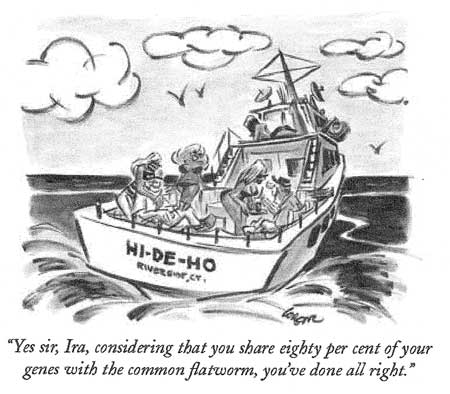
The first animal to have its genome sequenced was a tiny worm. It turned out that this little creature uses many of the same gene sequences that we humans do. For example, the genes for building its muscles tissues are identical to our own. Some of the other findings of the human genome project were even harder to accept.
Many of us were dismayed to learn that we have far fewer genes than we'd originally anticipated, somewhere around only 35,000 of them. Even worse, we found that we share about 97% of our genes with chimpanzees. And if that weren't insulting enough, our closest relative, the bonobo, has about 98.4 % of the same genes that we do.

Frans de Waal
The bonobo story is a fascinating one in its own right, for it has called into question many basic assumptions about the inherent nature of humans and our primate relatives. While we've always assumed that humans are wired to be rather aggressive and competitive - like the chimpanzees - the bonobos live in much more cooperative and peaceful groupings. Females are the dominant figures in the social hierarchy and sexuality rather than aggression is typically used to resolve disputes.
In contrast to the chimpanzees (and humans), the bonobos show almost no violent conflicts between competing bands, there is no rape, and they don't kill their babies. Bonobos appear to be able to laugh, they have some capacity for empathy, and they are the only species besides humans that make love in the missionary position.
Differences in the sexual behaviors of the primates are enlightening. Chimpanzees engage in sexual behaviors around every seven hours or so. Bonobos have sex in some form or another about every 90 minutes. These figures reflect the behaviors of specimens that are in captivity. It's hard to know how these animals behave in the wild, when they have other things to do.

Frans de Waal
Of course, it's difficult to say where humans fit into this since we're only found in captivity. And we alone can engage in sexual behaviors by manipulating symbols in our mind and attaching erotic thoughts to them. By that standard we appear to be the undisputed sexual champions of the primate world. Studies suggest that human males typically think about sex at least every few minutes.
In addition to sex, bonobos have developed another mechanism for fending off violent conflicts. When two bonobos fight the altercation typically stops as soon as one of them has gone to his nest. If the nest is too far away one may hastily throw a couple branches together in a tree and jump on top of them. It's like the nest is a safe place that can't be violated. Exactly the sort of haven that humans need so badly but can rarely access in our mental health systems.
The difference between bonobos and their more aggressive chimpanzee relatives appear to have developed over the last two million years, in direct response to differences in their environments. The two species have always been separated by the Zaire River. North of the river, where the chimps live, food is in scarcer supply. This is mainly due to the fact that the chimps share their range with gorillas, who snap up the choicest plants to eat. The bonobos don't have to compete with gorillas so food is more plentiful.
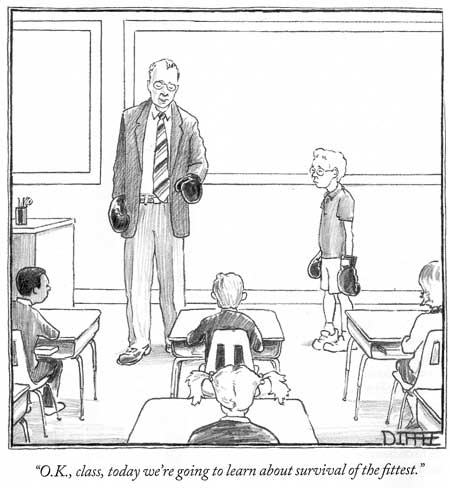
All of this raises an issue that will be repeated throughout this work. DNA is an incredibly adaptive and flexible molecule that responds to differences in the environment. If humans seem to be more aggressive and competitive than some of us would like, that may be due to the fact that the things that we strive for are in too short supply, rather than some hard-wiring of our nervous systems. Changes in the way that our species develops over the coming millennia will take place as a result of differences in the environments that we live in and, especially, the environments that we raise our children in.
The idea that something as miraculously complex as a human being could result from the actions of a mere 35,000 genes seems impossible until one considers the fact that these genes are the basis of a very dynamic system of communication. If one thinks of a piano with 35,000 keys the amazing possibilities and combinations become apparent.
The genes determining our brain structure and functioning are, indeed, quite dynamic and responsive. Our brains build new synaptic connections between nerve cells all the time. A single neuron may connect with several hundred thousand other neurons. When we're exposed to a stimulus for even ninety minutes our brains build new synapses in response. We're constantly shaping and reshaping our brains, strengthening or diminishing connections between our brain cells to meet the changing demands of our environments.
The idea that the differences between humans and bonobos could result from the actions of only about a 1.6 percent difference in our genes is pretty hard to grasp. It seems obvious that those 500 or so genes must be involved with something very important. Good looks or increased physical abilities probably don't explain it. We hope that it has something to do with our superior brainpower.
Human brains differ from those of other primates in three main areas- the frontal lobes, the hippocampus, and the cerebellum. All of these structures are much larger in us than would be predicted based on our size. So it's reasonable to assume that these brain areas are somehow related to the increased cognitive abilities that are typical of our species- as well as the fact that we suffer from mental illnesses.
We'll see that those three highly developed brain structures allow humans to do all sorts of amazing things. We can manipulate symbols and create realities in our heads that can stand quite apart form the external reality that all other animals share. But we're really not quite as different from chimps or bonobos as we'd like to believe.

For humans, our perceived place in our social hierarchies has a major role in how we feel about ourselves and the resultant realities that we live in. We have new brain mechanisms capable of all sorts of amazing feats. But the advanced processors that allow us to remember, imagine, plan, and create are still basically wired up to emotional systems that are not too different from those of our primate ancestors. We continue to be driven by the same instincts and emotions. It is as though we have a super-fast computer hooked up to a chimpanzee emotional system, as much as we would like to deny this about ourselves.
We humans are still basically troop animals. Where we stand relative to other humans around us is critically important to us. We spend inordinate amounts of time and energy trying to convince ourselves that we are superior to other humans. Obtaining expensive cars, fancy homes, attractive clothing, and large bank accounts motivate us in ways that we only dimly understand.
Our species is obsessed with sexuality. It occupies much of our mental life and is a constant subject in our entertainment media. We are driven to see ourselves as attractive mates, even when there is no evidence in the environment to support this notion.
Anyone who has experienced the American freeway system knows firsthand that we're still aggressive territorial animals. Many of us believe that we own the rights to the left hand lane. Everyone reacts emotionally as though the stretch of road in front of them and immediately behind them is theirs and theirs alone. Many of us would try to pass other drivers if we were on the way to our own execution by torture.
Watching the behaviors of Americans as they try to assert dominance over other drivers calls to mind that of chimps as they fight over who will get the choicest bananas or be able to sit on the sunny rock. This is just part of our competitive nature. At our most basic levels we are constructed to be extremely self-centered and to strive for the highest social positions available to us.
In psychoanalytic theory there are just two main drives that shape human behavior- the sexual and the aggressive. Whatever else separates us from the other primates as a result of that 1-2% difference in genes, the emotions we feel and the things that we strive for are still qualitatively the same.
The process of reality construction
Our big human brains weigh in at around three pounds and contain somewhere on the order of a hundred billion neurons. Far from being inanimate wiring, each of these cells is alive, has its own jobs to do, and is even presumed to have some sort of consciousness of its own. In one ingenious experiment a researcher trained human nerve cells in laboratory dishes to discharge at the rates he wanted by rewarding them with little squirts of dopamine when they did so.
Some of these neurons carry information to other cells. Others store data in potential form, waiting for the signal to release it. Still others are helper cells, tending to the needs of those involved in the information processing. All of these cells talk to each other in a variety of different ways. The release of chemical neurotransmitters across synapses is the one that receives the most attention.
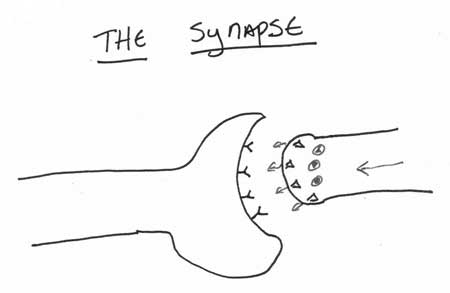
Nearly every psychopharmacology lecture in the last 50 years has included a slide something like this one. Most weren't quite so phallic but they all made the same basic points.
We've long assumed that our medications work by increasing or decreasing the actions of one of these neurotransmitters but those events at the synapse are turning out to be just a small part of the communication between nerve cells. When a neurotransmitter crosses a synapse a whole cascade of chemical reactions takes place in the next cell. Ultimately, the result is a gene being turned on or off. This, in turn, influences the production of other chemical messengers.
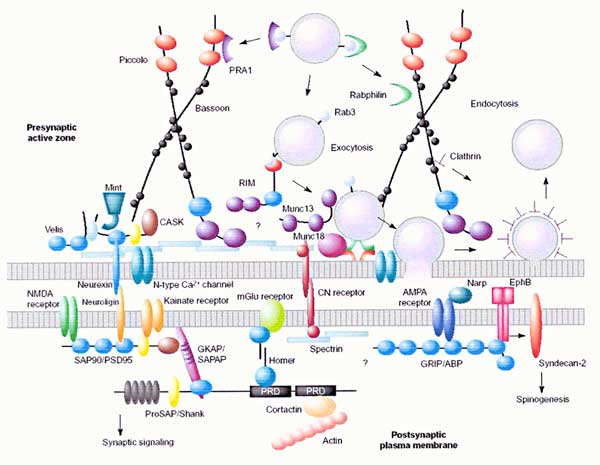
molneuro.kaist.ac.kr/psd
This is a more modern view of a synapse but even this is quite simplistic compared to the real thing.
Our neurons also communicate via the release of hormones, allowing larger groups of cells to be contacted. Some cells speak to each other via the release of nitrous oxide. There are undoubtedly forms of communication that we don't yet know about. But it's easy to get lost in the details of how neurons communicate with each other at the expense of what it is that they're actually talking about.
We humans are, like all creatures, awash in a sea of energy. Light, heat, gravity, motion, and electrical energies are just a few of the forces that constantly impinge on our nervous systems and bid for our attention. All organisms must select from the types of energies that they can perceive with their senses to construct an inner model of "what's out there". These inner representations of external reality will vary from species to species depending upon the types of energy receptors that each species possesses. All organisms have basic tasks that must be attended to as they interact with external reality. Feeding, defense, and mating are given priority when decisions are made about what energies to attend to at any given moment.
The process of organizing sensory input into a coherent picture of external reality is enormously complex. Fascinating and informative things take place when problems occur at the basic levels of perception. Experiments have shown that kittens who were raised from birth in a visual world artificially composed of only vertical stripes were blind when transferred to an environment of horizontal stripes. The raw neurological symbols for "horizontal" had not been developed through experience. Similarly, frogs will starve to death if the only food available to them is freshly killed flies. The frog nervous system can't recognize its favorite food as food unless it is moving.
Human examples abound. One involves a man who had brain surgery in an attempt to tame uncontrollable seizures. He had had no unusual sexual interests prior to the operation but afterwards he could only become sexually aroused by the presence of a safety pin. A short circuit had developed in parts of his brain involved with assigning emotional responses to his picture of external reality.
As mentioned in the last section, there are three main areas of the human brain that are strikingly larger and more highly developed in humans than would be predicted based on comparisons with other primates' brains: The frontal cortex, the hippocampus, and the cerebellum. These brain areas are primarily involved with creating, storing, responding to, and manipulating complex symbols. It is the differences in what our brains do with symbols that, ultimately, make mental illness a uniquely human phenomenon.
Within the past decade neuroscientists have discovered that one or more of these three key areas are typically abnormal in each of the major mental illnesses. The understanding of mental illness is now shifting from a focus on neurotransmitters to looking at changes in the structure and interrelationships of these brain areas that are involved in creating our own personal versions of reality.
Some general findings about the structure and functioning of these brain areas in the major mental illnesses are summarized in the confusing table seen below. It's hard to really talk about the brain area called the Hippocampus without considering its close neighbor, the Amygdala, so there are actually four brain areas summarized. This is a relatively new area of study and conflicting reports emerge. By no means should this be regarded as a definitive summary but the basic idea that there are abnormalities in these areas - changes in structure, activity, biochemical concentrations, cellular architecture, and symmetry - in the major mental illnesses now seems pretty certain.
| Hippocampus | Amygdala | Frontal lobes | Cerebellum | |
|---|---|---|---|---|
| Schizophrenia: | decreased volume, decreased activity, altered shape, decreased activation during memory tests | decreased volume on left | hypoactive, loss of gray matter | asymmetry, ? Enlarged |
| Bipolar Illness: | Left > Right? Neuronal loss | increased size | white matter lesions ? decreased gray matter | ? increased volume |
| Borderline Personality Disorder: | decreased volume | decreased volume | decreased L orbital-frontal volume | |
| Depression: | decreased volume | abnormal blood flow, increased activity |
Moving symbols instead of muscles
Perhaps it is our large frontal lobes that are most responsible for the differences in brainpower between we humans and all of the other creatures. During the period between fifteen and twenty weeks of fetal development this area produces an astounding 250,000 new brain cells per minute, causing it to overgrow everything around it.

www.brainbasedbusiness.com/2006/09/make_frien
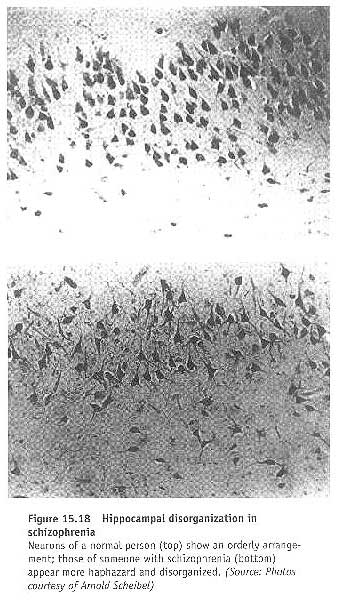
Each of those neurons must migrate to its final position, recognize other neurons that it must communicate with, and build the sorts of connections that will allow them to talk to each other. A host of things can go wrong. Toxins such as alcohol, a lack of oxygen, problems in the immune system, and stress hormones in the mom's circulation are just a few of the factors that can affect this migration and connection process. We're discovering that in some disorders such as schizophrenia entire layers of nerve cells don't migrate to where they're supposed to.
It is helpful to think of these frontal lobes as an outgrowth or expansion of the brain's motor system. That does seem to be the case anatomically- the frontal lobes seem to be tacked right on to the motor strip. Other animals basically move their muscles and limbs in response to changes in their environments. Because of this extension of our motor system, however, humans have the ability to move symbols as well as muscles. When confronted with changes in our external world we can use our frontal lobes to create a variety of potential options in our minds and choose among them, rather than being limited to a few stereotyped behavioral responses.
Ultimately, this newfound ability to create a separate world of symbols and manipulate them on our "inner screens" underlies every talent and achievement that makes us different from other animals. Thinking, planning, and problem solving are all manifestations of this human capacity for creating an inner symbolic reality that stands quite apart from consensual external reality. We even have the unique ability to attend to two realities at once, as when we drive our automobiles while simultaneously thinking about our plans for the evening or considering how we'll get back at someone that offended us.
From an evolutionary standpoint this talent for maneuvering symbols is brand new. It has allowed humans to have an unprecedented impact on our planet. Communication, transportation, and creativity have been elevated to levels that no other organisms on this planet could ever approach. But when brain functions are so new and different there are a lot of things that can go wrong with the structures responsible for them. The study of mental illness is, ultimately, an exercise in understanding the huge list of things that can go awry in these new domains of brain structure and functioning.
A simple example of an enormously complex process
Let's consider a simple illustration. Imagine that you've parked your car in a ramp at a local shopping mall. The lighting is dim and you're alone. When leaving your vehicle you see a stranger approaching. As he comes closer he says something that you can't quite make out, then reaches into his pocket and tosses something towards you from about ten feet away.
During the brief moment that the object is in the air your nervous system accomplishes a number of tasks at an amazing speed. It gauges the speed and trajectory of the unknown object, easily anticipating where it will be in space when it nears you. To perform these basic calculations with a paper and pencil would require a knowledge of physics and mathematics that few of us possess. And as the object approaches the brain makes a host of more impressive determinations.
As light that reflects off from the object reaches you an electrochemical reaction takes place in the retinas of your eyes. The resulting nerve impulses race to the back of the brain via four main bundles of fibers, two of which cross near the pituitary gland.
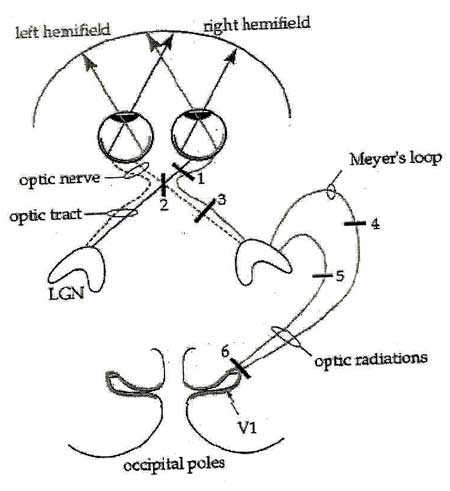
These pulses of electrical energy reach the primary vision centers and begin to be processed but so far the incoming data is not in useable form. It must be further processed in a sequence of two visual association areas, comparing the input to stored symbols of things that the eyes have seen before. Once the visual information has been properly buffed up it is immediately transmitted down into the limbic system, the evolutionarily ancient part of the brain that is heavily involved with memory and emotion.
The limbic system then must exchange information with the frontal lobes. The incoming stimuli are compared with existing symbols held in the long term memory banks. Those symbols exist in some potential form all of the time but must be activated and blended in response to the specific nerve impulses that come in. Your brain must then address a number of important questions about the approaching object: What have you seen like this before? Is the object alive? Is it sharp? Is it heavy? Is it dangerous? Is it something you want?
Once your brain has made its best-guess determination of what is approaching out there in external reality there is still a lot of work to do. It must assign appropriate emotional responses to the situation that it believes is developing. Should you be terrified, amused, excited, or angry? What intensity should be given to the emotional response? Should you be a little bit frightened or fear for your very life? Mildly irritated by the stranger's intrusion or enraged to the point of attack? You might have a different response from one day to the next, depending on other things going on in your life at the time. Obviously, other people would emotionally respond to the same situation in very different ways.
The number of factors influencing the emotional reality that you happen to create in the parking lot that day is almost limitless. A person approaching at two a.m. will likely elicit a different reaction than someone at two p.m. A female's approach may bring up different emotions than a male's. The age, race, and size of the stranger may all impact on your reactions. Your personal history will also influence your assessment of the situation. People who have been subjected to cruelty or abuse will be more likely to react to innocent settings as though they were dangerous. We can only construct our picture of the world with the symbols that are neurologically available to us at any given moment and those symbols are intimately linked to things that happened in our childhoods.
After the brain has made its best effort at determining what is out there and what emotions to activate it must still choose from an array of possible behavioral responses to the unfolding situation. What should you do in response to the approaching stranger? Run? Jump back into the car and lock the doors? Throw up your arms in self-defense? Scream? Attack? Or simply extend your right hand to catch the roll of hundred dollar bills that a wealthy philanthropist had decided to donate to the first shopper he met at the mall that day?
This exercise illustrates some important points. Most crucial is the fact that our nervous system must actively create a moment to moment representation of external reality -of what is "out there". The fact that all of these many tasks seem to occur instantaneously camouflages the sequence of actions and decisions that are actually taking place as we construct our complex versions of reality. It is easy to forget that even though the gap between an external event and our perception of it might only be a few microseconds, that is still an enormously important gap. For tiny particles moving near the speed of light a microsecond might seem like a very long time.
The difficulty that we face is in getting past our conviction that we are just experiencing reality as it exists, as though it is always the same for everyone. The only reality that anyone can know is the neurological representation of it that is created in one's head. Once that fact is truly appreciated it is easy to understand some of the things that can go wrong with the process of reality construction. And mental illness can start to make sense.
Balanced brain systems
A basic principle found throughout our nervous system is that there are always two opposing systems that are set up in a dynamic balance. The system controlling the movement of our muscles is a good example. Flexors move our limbs in one direction, extensors in the other. Maintaining normal posture or moving our limbs smoothly requires an ongoing balance in the brain systems controlling these muscle groups. Imbalances can result in jerky movements, tremors, or spasticity.
The brain systems involved with creating a representation of external reality, and with assigning proper emotional responses to it, must be balanced in a similar way although these systems are much more complex and difficult to understand.

Most people are now aware that the brain is constructed of two large hemispheres. The idea that each of these hemispheres sees reality in somewhat different ways is also generally understood, but the implications of all this are not as clear. Below is a summary of some of the differences in the ways that our hemispheres commonly perceive the world.
| Left Hemisphere | Right Hemisphere | |
|---|---|---|
| Logical | Intuitive | |
| Sequential | Non-linear | |
| Time oriented | Timeless | |
| More cheerful | More depressive | |
| Detail oriented | Big picture | |
| Verbal focus | Non-verbal communication | |
| Abstract | Concrete |
Our tendency is to think of specific brain functions as being located in one hemisphere or the other. People may ask questions like "which side is mathematics located in?", as though their difficulty with the subject must be a result of one hemisphere's failings.
The fact that each of these hemispheres forms its own representation of reality, complete with its own emotional responses, talents, and areas of difficulty, is harder for us to picture. The idea that we simultaneously form a second world view that includes different political opinions, different morals, and different ideas about ourselves seems almost preposterous. But experiments in which the two hemispheres are separated via surgical or chemical means tell us that this is indeed the case.
One thing that seems clear is that we should not be aware that we have two distinct views of reality going on in our consciousness at the same time. This can get a little distracting. When our brains are working properly the two realities should be nicely balanced into a seamless whole. One of the most appealing theories of schizophrenia suggests that its symptoms may result from a difficulty in maintaining a proper balance between the realities generated by the two hemispheres.
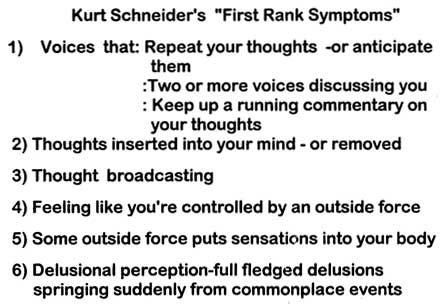
These " First Rank Symptoms" of schizophrenia have been acknowledged for decades and have had tremendous influence on how we currently diagnose that disorder. A psychiatrist named Henry Nasrallah has theorized that most of these symptoms can be conceptualized as the "dominant" hemisphere's misinterpretation of information coming to it from the non-dominant one. Hearing voices, believing that an outside force is monitoring one's thoughts or trying to control one's behavior, and other symptoms of that nature may simply reflect ways of interpreting and explaining experiences that occur when this information from the non-dominant hemisphere bleeds through into conscious awareness. Sort of like receiving two TV channels on your screen at once.
Some tests that have been developed to determine which hemisphere is "dominant" support the notion that normal patterns of dominance between the hemispheres do go awry when people are psychotic. Treatment with antipsychotic medications may help to reestablish a hemispheric balance in which those intrusive inputs into the picture of reality are once again kept out of consciousness.
There are many other brain systems that must be kept in a reasonable balance if we are to remain mentally healthy. One appealing theory holds that we have within us two distinct "reality generators" (that are not the same as the realities created by the two hemispheres). One generator forms a pretty exact reproduction of "objective" external reality as we experience it during clear consciousness. The other forms the "subjective" reality that we experience in pure form during our dreams. The idea is that these two "reality generators" must be kept in a proper balance as well.
When there is too much input from the "objective" generator consensual reality looks the way that it should except that it is "flat" in terms of the emotional component. The person does not attach the proper motivations, emotions, and creativity to his world view. When the balance is shifted towards the "subjective" generator there is lots of emotion and personal input into the view of reality but the world can be experienced in strange ways. Dream like intrusions into the picture of reality can occur. In fact "dreaming while one is awake" may be the simplest and most accurate way to conceptualize many psychotic experiences.
The fact that we actively construct our own views of the world is certainly not easy to grasp. The idea that these constructions are the result of an interplay between opposing systems that are inclined to see things very differently requires even greater reach. But so far we have been looking only at the process of creating a picture of external reality and responding to it emotionally. As complex and puzzling as this is, it only touches on the enormity of the brain's constant task. For we not only react to the ever-changing world around us. We must also attend to our inner world of thoughts and imagination.

Our uniquely human problem is that we must deal with realities that might happen, in addition to those that are happening. We attach emotions to our thoughts about things that may or may not take place tomorrow. In addition, memories and possible interpretations of past events compete for our attention and emotional responses. We can replay the events of yesterday in our heads for weeks, coming to different conclusions about what the meanings of those occurrences might be and feeling different emotions in response to what we believe took place.

Imagine that you were in a meeting last week with eight coworkers and your boss. You said something impulsively. Some people might have thought that it was a bit outlandish or politically incorrect. Perhaps it will influence your standing in the company. Maybe it was really insignificant and no one even remembers. It's possible for you to replay that event in your mind thousands of times, with a multitude of different emotional responses.
To complicate things further, you can replay the event from the perspective of each of the other people in that room, imagining how every one of them might have reacted to your possible faux pas. Different emotions arise within you depending on what you conclude that each of the coworkers thought of you. Your employer's possible reaction is given even more emotional weight. What did he think of your comment? Was he angry or amused? Does he value your fresh approach to things or think that you're brash and immature? We humans run these sorts of possibilities through our minds all of the time.
To make things even more complex, we can perform these mental gymnastics while we're doing other things at the same time. It is possible for humans to attend to two separate realities at once. How many of us pay complete and total attention to current external reality when we're sitting through lengthy Powerpoint presentations?
This separate inner world of thoughts, memories, and imagination is almost always taking place while we try to attend to the demands of the present. Thinking is the most important and pervasive of our brain's symbol manipulating activities. From the moment we wake up until we finally drop off to sleep the process of thinking dominates our consciousness. We talk to ourselves constantly and, of course, our own lives are the main topic of conversation. Many of us are only jolted out of our world of thoughts on the rare occasions when something crops up in external reality to demand our attention for a moment. We then return to our thinking as quickly as possible and continue until another irritating intrusion occurs. And emotions can be attached to every one of those thoughts.
How does a nervous system decide what emotions should be activated at any given moment? How does a brain strike a balance between emotional reactions to the world of thoughts and emotions arising in response to external reality? This is all so new in evolutionary terms. It comes as no surprise that we'd have trouble balancing all of these competing demands.
Estimates suggest that as many as twenty five percent of humans have enough problems with these basic processes to warrant a diagnosis of mental illness. But it's not like mentally ill people have problems with these functions while the rest of us have brains that work perfectly at all times. This job of balancing thought, emotion, and the experience of external reality is so amazingly complex that each of us is bound to have problems with it on occasion.
The list of things that can go wrong in the formation of the brain structures responsible for these tasks, and in the resulting formation of our realities, is so long that it seems endless. That fact that these brain systems are ever able to work in a smooth and coordinated manner is a miraculous human achievement.
Dual Pleasure Systems
One of the most peculiar things about humans is that we can attach varying degrees of pleasure to our experiences, and even to our emotions. Some people can even find physical pain or emotional degradation pleasurable in the right settings. The whole business of pleasure is one that has received little attention in psychiatric circles. Our focus has been on the elimination of various symptoms of mental disorders. The capacity to experience pleasure is not something that we're prone to thinking about. But for individuals the capacity for pleasure is, of course, enormously important.
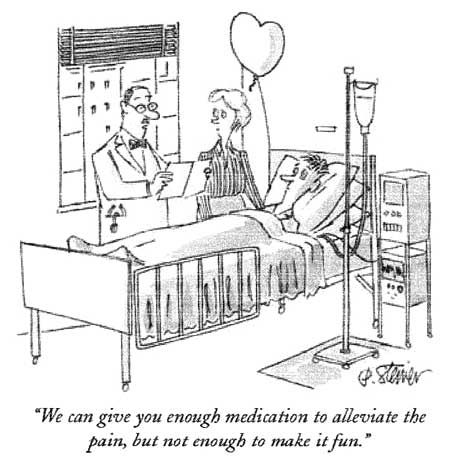
As with other brain systems, it's looking like pleasure involves two different systems that require balancing to work properly. Researchers call them the Consummatory and the Appetitive pleasure systems.
The pleasure brought about by the Consummatory system has been termed "the pleasure of the feast". It is the sort of pleasure that we experience after a satisfying meal or having sex. The chemicals responsible for Consummatory pleasure are the endorphins. The drugs that mimic this pleasure system are the opiates.
Consummatory pleasure, whether brought on naturally by a big meal or from outside by pills like Oxycontin or Percodan, is an inactivating pleasure. After people eat Thanksgiving dinner the tendency to just lay on the couch can be irresistible, even when it means having to watch the Detroit Lions play on TV. Opiate addicts don't move around much after a heroin injection. Just sitting in one place, even in terrible surroundings, is pleasurable enough.
The Appetitive pleasure system is very different. It is an activating pleasure system. Its pleasure has been called "the pleasure of the hunt". The neurotransmitter involved with Appetitive pleasure is dopamine. The drugs that mimic this pleasure system are the stimulants, especially cocaine. When this system is turned on the individual is active and alert. It is hard to sit still. Both physical and mental movement feel essential.
The idea is that these two pleasure systems should be held in an optimal balance. As a simple example, think of our hunter-gatherer ancestors. As the time since the last meal increased they became progressively hungry. The activity of their Appetitive pleasure systems increased. They were stimulated to explore their environment searching for food. When they found food and feasted their Consummatory pleasure system kicked in. A period of inactivity followed until hunger started to set in again.
Most people with the severe mental illnesses appear to have relatively intact Consummatory pleasure systems. They are still driven to eat, drink, and smoke -often to excess- because consuming these things brings about pleasure. The Appetitive system can be much more problematic however.
When the Appetitive pleasure system is turned up for too long a time, either through mental illnesses or the abuse of stimulant drugs, strange things start to happen to people. They become increasingly irritable and suspicious, sleep poorly, and lose their appetite. If the Appetitive system remains activated long enough people start to show paranoia and delusional thinking. The clinical condition brought about by the prolonged use of stimulants may be indistinguishable from Paranoid Schizophrenia.
It seems likely that many people with mental illnesses have something wrong with this balance between their two pleasure systems. Perhaps a sensitivity to the stimulating effects of dopamine is involved.
Dopamine is a neurotransmitter that gets a lot of emphasis from pharmaceutical companies. All of our major tranquilizers, or antipsychotic medications, are designed to inhibit dopamine flow. But once again the commonly held notion of a primary chemical imbalance causing a mental illness, and the idea that decreased dopamine equals decreased psychosis breaks down under scrutiny.
It turns out that there a variety of subtypes of dopamine. The Dopamine 2, or D2 receptor, appears to be most heavily involved in the response to antipsychotic medications. It seems to be involved in chemical reward systems in the brain, as well as playing a role in linking brain areas involved with thought, imagination, and emotion. But this particular receptor can exist in two different states. In its activated, "high affinity" state it is hungry for dopamine and very responsive to it. And too much dopamine flow can be associated with psychosis.
These dopamine receptors can also exist in a low affinity state in which they aren't so responsive to dopamine flow and are less likely to cause psychotic symptoms. It is suspected that environmental variables, as well as our self image, can have a lot to do with the state that these crucial dopamine receptors will be in at a given time.
Dopamine and the Environment
When we see ourselves as being in danger, whether the threat is to our safety or to our self esteem, we're likely to activate those dopamine receptors. It seems likely that our current practice of housing mentally ill people in cramped, crowded conditions, usually in undesirable or frightening neighborhoods, is ultimately causing activation in these very dopamine systems that they have so much trouble regulating to begin with. The need for dopamine blocking chemicals increases.
One thing about the current American system of psychiatric care that is usually overlooked is the way people respond to psychiatric hospitalizations. The average length of stay in an acute care psychiatric hospital runs significantly short of a week these days, regardless of what disorder you suffer from or what part of the country you live in. And people commonly improve during their hospitalizations, leaving the hospital feeling at least somewhat better than when they came in. Most of them have some changes made in their combination of psychotropic medications and we usually attribute the clinical improvement to the changes in the drugs. But the medications that are given all require longer than a week to work.
People are routinely getting better before the medication changes are taking effect. The effects of the changes in their environment - having a safe place to sleep, some decent nutrition, and caring attention from other humans- results in brain changes and clinical improvement.
A recent study with monkeys further strengthens the idea that the Appetitive pleasure systems in our brains change in response to changes in the environment. Researchers housed a number of monkeys in individual cages and studied their dopamine receptors using sophisticated PET scanners. There were no observable differences between the monkeys. Then the monkeys were put into group cages and restudied.
The monkeys of higher social ranking - the "dominant" monkeys - changed their dopamine systems significantly. An increase in dopamine receptors was observed, probably reflecting an increased manufacture of dopamine. The non dominant monkeys did not make this change in their dopamine systems.
All of the monkeys were then given intravenous solutions. They could choose to push a button that would give them saline solution - salt water - or one that would administer intravenous cocaine. The dominant monkeys didn't show any preference for the cocaine at all. The non-dominant monkeys couldn't push the cocaine button fast enough.
That experiment suggests several basic things that are extremely important if they hold true:
Changes in our environment can cause significant changes in brain systems involved with activation and pleasure.
Being grouped with other humans, especially not of our own choosing, can result in brain changes that make substance abuse more likely.
The perception of our status or ranking in our social groups has a tremendous impact on how we respond to our environment and how our very brains are structured.
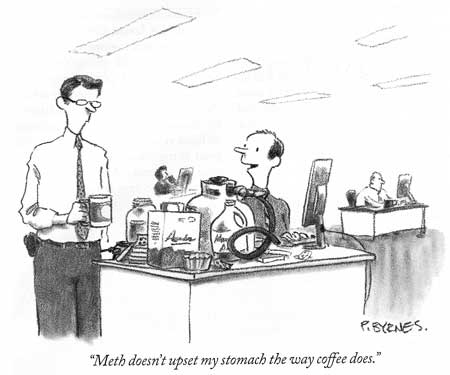
The implications for a society that is struggling with what to do with its millions of poor people that live in dismal conditions and abuse drugs like cocaine and methamphetamines are, obviously, extremely important.
Take any 100 people that you can think of. Put them into a crowded environment and give them the message that they're inferior to other humans. Feed them a diet poor in nutrients that are essential to healthy brain functioning. Add mental inactivity and a lack of exercise. Throw in hopelessness, unemployment, poverty, and some actual disincentives to becoming more independent. Does the statistical risk of crack abuse go up at all?
In a very real way it appears that we're commonly setting people up to fail. And a basic idea here is that it's much more expensive to try to pick up the pieces when mentally ill people fail than it is to give them a realistic chance at success.
The dopamine story is even more complex and important than we've seen so far though. We have learned about how flexible and adaptive these brain systems really are. When we try to treat people with mental illnesses with our powerful dopamine blocking medications the brain responds with changes of its own. Block dopamine flow and the brain builds more dopamine receptors in response. There are now suggestions that this phenomenon may even be changing the way mental illnesses affect human beings over time.

Psychiatrists working on inpatient treatment units will routinely report that the single most common reason for psychotic decompensation and hospitalization is the client's decision to stop taking antipsychotic medications. There is a long list of reasons why people stop taking their medications.
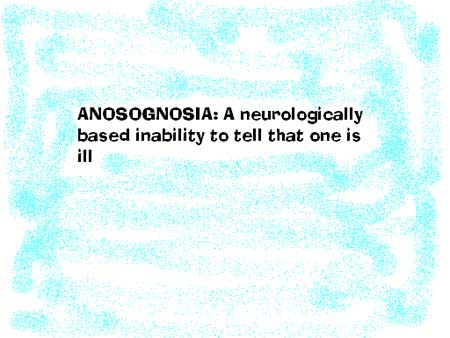
Anosognosia, the neurologically based inability to tell that one is actually ill, is probably the most common one. If your brain cannot carry on the complex comparisons of representations of the self - before and after illness, on and off medications - then it's very hard to truly conclude that you're ill. The only reality that we can know is the one that our nervous system puts before us.
Without awareness of illness - and about 70% of people with schizophrenia experience this problem with anosognosia - psychiatric treatment may be experienced as something that's inflicted on you for problems that you don't really have to begin with.
Regardless of why medications are stopped, the brain can be left in a very different state when this occurs. It has built up more dopamine receptors in an attempt to get around the dopamine blocking drugs. A dramatic increase in dopamine flow can result when the medications leave the system and dopamine hits that enhanced dopamine receptor system. Sometimes patients decompensate into agitated psychosis rapidly. And everyone's conviction that all of those dopamine blocking drugs were necessary is further strengthened.
Several studies done by the World Health Organization have found that a person with schizophrenia actually has a better chance of recovering from the illness if they live in undeveloped countries where antipsychotic medications are not available. This is very troubling. Certainly some of the improvement that people with schizophrenia show in the Third World may be related to environmental variables such as tighter family groupings and fewer of the stressors typical of urban life. But we can't discount the possibility that our medications may be causing long term brain changes that make recovery from schizophrenia less likely.
Advocating for the abolishment of antipsychotic medications is an extreme, and many of us believe, irresponsible position. The vast majority of psychiatrists would want our children to take antipsychotic medications if they developed schizophrenia. But we probably would not want our own children to be treated in the way that most people with schizophrenia are currently treated in our society.
We'd want our loved ones to live in environments that give their brains the best possible chance of working adequately. In the sections on community treatment we'll develop some ideas about what optimal living environments for mentally ill people might look like in the future.
Most of us wouldn't want our children to be treated with dosages or combinations of medications that weren't absolutely necessary. We certainly wouldn't want them to have to receive large amounts of several antipyschotic medications just to feel calm enough to survive in environments that would make any sane person nervous. We wouldn't want our children's illness to be conceptualized as the result of something as simple as a "chemical imbalance".
Does the Cerebellum Balance Opposing Brain Systems?

www.brainexplorer.org
As it becomes increasingly clear that brain systems that must be kept in balanced relationships are responsible for the realities that we experience and the emotions that we attach to them a good question becomes "what does the balancing?"
The cerebellum is becoming the prime candidate. Remember that the cerebellum, along with our frontal lobes and hippocampus, is much larger in humans than our physical stature would predict. In fact this mysterious structure contains over half of the brain's neurons. The commonly recognized function of the cerebellum is the coordination and balance of muscle movements. Our talents in that area certainly would not explain the need for such enlarged cerebellums.
To understand this we need to revisit the idea that our frontal lobes are essentially an outgrowth of our motor systems. Humans must balance all of those symbol-moving capacities in addition to the muscle movements that the cerebellum is more commonly associated with. The role of the cerebellum in mental illness is not yet well understood but it is now clear that it is involved in many, if not all, of them.
The balancing of opposing brain systems seems like a logical contribution of the cerebellum. The smooth coordination of inputs from each of the cerebral hemispheres and the balancing of the "Hippocampus" and "Amygdala" systems discussed in the next section are likely cerebellar functions too.
Keeping our subjective and objective "reality generators" in proper balance and coordination of the inputs of our dual pleasure systems are other tasks that the cerebellum may be responsible for. Even the smooth flow of our thoughts might be mediated here. We can anticipate that research in the next decade will bring a new awareness of the important role that the cerebellum plays in the major mental illnesses.
The almond and the seahorse: A dual emotional processor hypotheses
One of the most exciting areas of neuroscience research in the past decade has been the growing awareness that the area of the brain called the hippocampus appears to be abnormal in all of the major mental disorders. Hippocampus is a very technical sounding term but it really just means seahorse - a name that it was given because some researcher thought it looked like one.
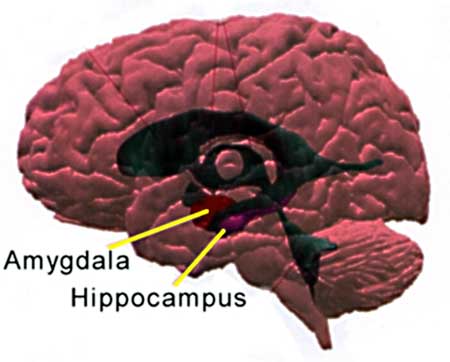
Scientists have recently been amazed to learn that the hippocampus is one of two known brain structures (the olfactory cortex - the area involved with smell - being the other) that manufactures new brain cells each day.
It's quite likely that this process of generating new brain cells may be essential for the formation of new memories. The idea that nerve cells that are created today are somehow related to the memories that are made of today has tremendous intuitive appeal. The fact that these two brain areas make new brain cells daily may also explain the common phenomenon where a smell can trigger very powerful and specific memories. But this is clearly an area in which the findings coming out of laboratories are far ahead of the theories available to explain them.
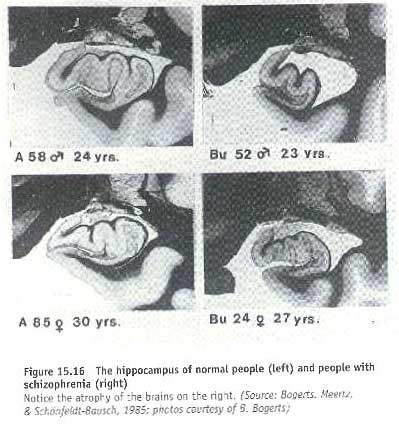
Research has found that the hippocampus is often small and misshapen in schizophrenia. Its volume may also be reduced by as much as 20% or so in major depression. Childhood trauma and abuse, as is so frequently seen in Borderline Personality Disorder, also can result in smaller hippocampal volumes.
In the past few years we've been surprised to learn that antidepressant medications and electroconvulsive therapy (ECT) may actually exert their antidepressant effects by stimulating the birth of new brain cells in the hippocampus.
Bipolar Disorder has been found to be associated with enlargement of the amygdala, a structure that abuts the hippocampus (amygdala just means "almond"- while the fancy names can be intimidating this stuff isn't rocket science). So there does seem to be an association between structural brain changes in these key brain areas and the emergence of mental illness. But how can we understand this connection?
The hippocampus is heavily involved in two major brain functions: the maintenance of a decent mood and the formation of new memories. Its activity appears to be inversely related to that of its neighboring amygdala. When the hippocampus becomes less active the amygdala's activity increases and vice versa.
Of course a variety of other brain structures (each with their own funny names) are also intimately involved in the processes of forming memories and moods but for the sake of this simple model let's imagine that there are two basic emotional processors. Let's call these processors "Hippocampus" and "Amygdala" after the two key structures that seem central to their functioning. In this model the bold italic versions will refer to the processing systems while regular typeface will simply refer to the structures themselves.
As the constant flood of highly processed incoming stimuli from our sense organs arrives in the limbic system it appears that we have two broad ways of sorting it all out.
"Amygdala" primarily assesses the stimuli based on emotional symbols and memories.
When this system asks "what is out there?" the first thing that it wants to know is if there is anything that is an immediate threat to our survival. Other basic instincts like sexual drive, feeding, and strivings for social dominance also get high priority here. When we feel that these instincts have been satisfied the pleasure can be intense. "Amygdala" is also highly connected to parts of the autonomic nervous system that control our "fight or flight" reactions.
In the example of the stranger approaching in the parking lot, most of us would experience sudden increases in pulse, blood pressure, respiration, and adrenaline as "Amygdala" sized up the situation and prepared us to do battle or run for our lives. This is a system that must be capable of responding quickly and decisively to changes in external reality. It's likely to attach particular emotions such as hostility, fearfulness, desire, and anxiety to our experiences. All of those feelings are experienced as powerful and immediate. When the balance is shifted towards excessive input from "Amygdala" depression, anxiety, impulsivity, irritability, and the abuse of mood altering substances all become more likely.
"Hippocampus" is the more modern system. In evolutionary terms one could say that it is still an experimental system. This system appears to separate us from the "Amygdala" based system of responding to our environments that all other animals must rely upon.
"Hippocampus" is the limbic system's gateway to the frontal lobes' memory banks and their capacity for imagination. It's interesting to consider that memory and imagination are so intimately related. Imagination is the creative combination of symbols already stored in memory. These neurological symbols are the very stuff that our representations of external reality and our memories are made up of as well.
"Hippocampus" is situated in a way that allows it to not only ultimately decide what events are to be stored in memory, but to later access those memories in our efforts to decide " what is out there". This is the system that allows us to creatively move symbols and mental representations in response to stimuli rather than just our limbs.
When confronted with a challenging situation we can ask "what have I seen like this before?" or "what are the possible meanings of this situation?". A human with a well functioning "Hippocampus" system could easily generate a list of dozens of possible reasons why a stranger might be approaching him in a parking lot, then prioritize them from most to least likely based on experience and intuition. We could also generate a list of possible responses to the situation.
But problems can develop. We can become so preoccupied with moving symbols on our inner screens that we become incapable of fully participating in external reality. Sometimes we're so lost in our world of thoughts that a wad of money could land at our feet without even registering in our attention.
What Does "Hippocampus" Need To Thrive?
If one accepts that our brains have these two basic emotional processors- regardless of the terms that are applied to them- then some important questions naturally follow. What factors influence the neurodevelopment of these important brain areas? What is the role of early experience in shaping them? And what can we do as adults to maximize the functioning of these systems?
Over the past several years a significant amount of information has accumulated about the workings of the hippocampus. A number of factors appear to impact on the volume of this structure (or more properly structures - each side of our brain has one).
Physical exercise is important for the formation of its new brain cells. Environments that provide sufficient stimulation are essential. The role of sleep is becoming clearer. It looks like a gene called zif 268 is involved in the formation of new neurons in the hippocampus. Adequate sleep seems to be necessary for this gene to be turned on properly.
Novelty, or new experiences, also are emerging as important for hippocampus health. This makes good intuitive sense. Why would we devote a lot of energy to maintaining an active hippocampus if we aren't having any new or different experiences to remember? Similarly, challenges for the memory apparatus such as trivia games, crossword puzzles, or reading may have important benefits in maintaining the health of the brain systems devoted to memory and mood.
People familiar with the way our severely mentally people live in America will immediately recognize a problem here. As a rule, stimulating environments, novel experiences, new things to remember, and adequate sleep are in short supply throughout our mental health systems. Rather than trying to provide our chronically mentally ill people with enriched environments we have spent our resources primarily on providing expensive medications that are supposed to correct chemical imbalances. And the role of environmental variables in maintaining mental health goes far beyond providing those important positive factors necessary for a healthy "Hippocampus."
The Toxic "Hippocampus"
A number of things have been identified that interfere with the workings of the "Hippocampus" system. Excessive alcohol use and the abuse of opiates or stimulants are known examples - each can lead to the memory and mood problems that can be anticipated when "Hippocampus" is not functioning well.
The negative effect of stress hormones is probably an even more important and pervasive factor. Glucocorticoid hormones, the chemical messengers of the stress response, are known to inhibit neuronal growth in "Hippocampus". Prolonged exposure to stress can clearly lead to anxiety, depression, and impaired mental functioning. Our views of ourselves and the realities that we create can be very different when we're stressed and these underlying brain changes are undoubtedly a major part of this.

The catch is that we humans differ dramatically in terms of what we'll experience as stressful. Some people will drive across the country to ride a new roller coaster. Others would react to the same ride as though death were imminent. Our beliefs about ourselves, our past experiences, our support systems, and the current state of our brain all contribute to our perceptions of what is stressful or dangerous.
To complicate matters further, it looks like too little stress can be bad for brains too. Boring jobs can be even more dangerous to our health than ones that are clearly stressful. Feeling like one has some degree of control over what is about to happen is an enormously important determinant of what we'll experience as upsetting.
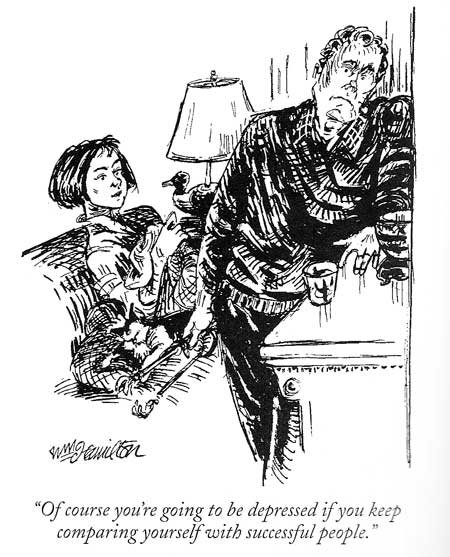
Problems come about when our efforts to see ourselves as occupying an important position on our social ladder are unsuccessful. When humans experience social rejection we respond by activating the same parts of the brain that we do when we experience actual physical pain. Threats to our self image and our perceived place among other humans are stressors of enormous importance.
The chemicals involved in these stressful emotions can be quite toxic to "Hippocampus". And we humans do not even need anything in our environments to activate these chemical cascades of stress hormones. We can drive ourselves crazy anywhere. Even a hike through beautiful wilderness can be marked by anxious thoughts about the opinions of people hundreds of miles away. And, at the same time, those people whose opinions we're so concerned about are probably thinking the same sorts of thoughts about what other people think of them.
Aberrant connections and their effects
Connections between the frontal lobes and the emotional centers can become too tight. Things that we think about or imagine can result in emotional responses that are too powerful or intense. Again, this occurs most commonly when issues of self-esteem are involved. Some of us know what it is like to lay in bed before sleep and recall stupid things that we did or said during the day. The painful feelings that accompany these memories can be so strong that they're experienced as a physical feeling in the belly, almost like a blow to the solar plexus. These kinds of experiences are even more common in the serious mental disorders.
Psychotic people often believe that everything revolves around them. Everyday occurrences, even the benign gestures of people on television, can be interpreted as having a special message for the individual. They may even feel that their actions or thoughts are so important that the very fate of the world depends on them.
The self-loathing that some mentally ill people must deal with can be extreme. All of the resultant stressful emotions can be disabling in the short term, and the hormonal responses to the stress can cause long term disruption to these circuits. Many mentally ill people have had periods of time in which their emotional system has been in overdrive for prolonged spells. There are now suggestions that in schizophrenia some of the important brain pathways are permanently damaged by excitotoxicity - stimulation in excess of what the neurons are able to handle.
The connections between thought, imagination and emotion can be too loose. Things that we think about may result in an emotional response that barely registers. Patients with "negative symptoms" of schizophrenia have enormous difficulty in mounting adequate emotional responses to experiences. Problems with will and motivation can be so severe that the person becomes essentially non-reactive to his world. Interestingly, patients with these negative symptoms often show pronounced abnormalities of their emotional centers when MRI scans or other sophisticated brain images are obtained. Despite the growing awareness that these negative symptoms are a function of how the brain is structured, people often react to those who suffer from these difficulties as though they reflect laziness or dependency.
Sometimes the "wrong" emotions are attached to thoughts and experiences. In fact this "inappropriate affect" is one of the cardinal features of schizophrenia. The most morbid thoughts can elicit hilarious laughter. Innocuous experiences can result in terrifying, life or death emotional responses. People can react with rage to kind hearted attempts to help them. Powerful emotions can be attached to everyday objects. People can be afraid of their furniture or believe that they are being stalked by fishing lures. The ability of "Hippocampus" to reflect on the emotions and use them as sources of information can be lost entirely.
Emotional responses can escape normal feedback mechanisms. Some people cannot become just a little upset or irritated. Once the angry emotions are triggered the feelings continue to build until rage is released through impulsive verbal or physical behaviors. Anxious or sad emotions can similarly escape control, although the results are usually not as visible. For some people it can seem like their emotional apparatus has no brakes.
Strangely enough, positive feelings can escape their normal controls as well. In mania the normally rewarding feelings of positive moods, increased energy, and creativity can run amok. Grandiose versions of the self, usually kept out of conscious awareness, begin to surface. Thoughts come too quickly and eventually begin to disorganize. Euphoria can turn to irritability as the brain is forced to go without sleep for extended periods of time. Lines between wish and reality can become blurry. While mania can have many causes, the consequences of this mismatch between experience and emotion are usually devastating for the individual.
Anxiety disorders may be the easiest to intuitively understand. In these conditions an excessive amount of emotional weight is given to mental representations of things that could happen. The brain overreacts to these potential realities, as though they were actually occurring in the present.
One of the anxiety disorders, Obsessive Compulsive Disorder, demonstrates another important feature that can go wrong when short circuits develop in these brain systems. In this disorder the thoughts can demonstrate characteristics of the muscle movement disorders that they're related to. The equivalent of "mental tics" can develop, with the same thoughts being repeated over and over. In fact we now know that there is a significant overlap - many people who have disorders causing the muscle tics also have the mental variety. Stereotyped behaviors like hand washing, checking, and counting may occur- again without any sense of volition from the individual.
These anxiety disorders emphasize the importance of being able to coordinate one's thinking. The ability to smoothly shift from one thought to the next, to stop a train of thought when it has gone on for too long, and even to stop thinking altogether for a while are essential talents if one is to remain mentally healthy. But in Obsessive Compulsive Disorder there are changes in the basal ganglia region of the brain, an area normally concerned with maintaining smooth muscle movements. Asking an obsessive person to stop ruminating may be akin to asking a person to stop a tremor.
Our emotions can be influenced by rhythms and cycles that we are only dimly aware of. The biological tendency towards inactivity as winter sets in or to become more energetic with the sunny days of spring can go awry. Many people become depressed in the fall, as day lengths shorten. The increased incidence of mania in the springtime is a well recognized phenomenon. There are so many factors that impact on our moods that we're usually unaware of them. Moods are prevailing tendencies towards particular emotional interpretations of experience. They save us the trouble of always having to create totally new emotional reactions to everything that happens to us.
So this business of attaching emotions and motivations to our experience is tremendously complex. Difficulties can occur when the brain structures involved are not built properly or when the balance between them is disrupted. The actual content of our thoughts and beliefs can result in chemical stresses to the very structures responsible for adding the emotions to our realities. A host of problems can develop.
Below is an attempt to summarize the growing body of research about the two very different ways that our brains have of connecting emotions to thought, imagination, and perception.
"Amygdala" System
The "default" emotional processor, ancient in its evolutionary origins
Emphasis is on emotional memory
Highly connected to physical "flight or fight" responses
Activity increases in depression and addictions
Not as amenable to self observation
Bias towards rapid responses, fear, irritability, hostility, and impulsivity
Less creativity and flexibility of responses
Very involved in chemical reward systems, especially dopamine
Takes over in times of stress, whether danger is real or imagined
"Hippocampus" System
Allows for a stable, satisfying mood
Able to use memories and symbols to reflect on the self
Can create and examine options for behavioral responses
Emotions are available for use as signals
Birth of new neurons is essential for its healthy functioning
Activity is boosted by antidepressants, ECT, probably by psychotherapy
A modern system in human evolution. A lot can go wrong:
- Requires active support to function well
- Needs intact wiring and the proper genes
- Empathic caregivers and freedom from abuse during childhood are necessary for optimal development
- Needs physical exercise and adequate sleep
- Requires relative safety and freedom from stress. Stress hormones are toxic
- Novelty and new challenges are necessary for good functioning
- A stimulating, enriched environment is needed
- Sensitive to toxic effects of alcohol, opiates, probably stimulants
- Falling estrogen levels can be deleterious to its functioning in women
- Activity seems to decrease when "Amygdala's" increases
Any enlightened system of mental health care will have to take into account the various factors that affect the balance between these two pleasure systems. If having a healthy "Hippocampus" system is really necessary for humans to function well- and get along with other humans- then we'll have to get serious about trying to provide mentally ill people with environments that allow it to have its best chance of working well.
The implications of developing a populace that's increasingly "Amygdala" based , with increasing propensity for anxiety, immediate gratification, violence, and substance abuse are too great to for our society to ignore.
Is anatomy truly destiny?
Despite all of our many advances in the neurosciences we still can't say with any certainty what causes any of the mental illnesses or how our diverse attempts to treat them actually work. But it's always tempting to believe that the answers to those questions are right around the corner.
A nice example of the depth that scientists are now able to look to involves a molecule called DARPP-32. This is a type of regulatory chemical that can control the actions of various areas of the brain by changing the sensitivity of their neurons. It seems to be involved at the level of how the receptors and ion channels in synapses behave. DARPP 32 also has a role in the ways nerve cells respond to chemicals like cocaine, nicotine, and opiates.
Two of those neurotransmitters that have been implicated in schizophrenia, dopamine and glutamate, work in opposite ways on the DARPP 32 molecule. One turns it up, the other down. A neuroscientist named Paul Greengard won the Nobel Prize for Medicine in 2000 for his work on DARPP.
It turns out that concentrations of this DARPP 32 molecule were found to be reduced in part of the brain that we've known is often abnormal in the brains of people with schizophrenia- the dorsolateral prefrontal cortex. This brain area appears to be involved in our ability to think abstractly. When people with schizophrenia are given tests that ask them to be able to see underlying patterns and be able to recognize when those patterns have changed they typically don't activate this part of the brain like other people do. The test that was used in the classic experiments- the Wisconsin Card Sort Test -is basically like the card game UNO.
Now it turns out that that same brain area - the dorsolateral prefrontal cortex - may also be involved in our ability to keep thoughts from coming into our minds. This is obviously a vital human talent. Without it we may feel that thoughts come to us without our conscious control or, as is so common in schizophrenia, are even imposed on us by some outside force.
So DARPP 32 may be involved both in our ability to think abstractly and our ability to control the thoughts that come to our minds. Pretty heady stuff for a molecule that didn't even enter into our brain models a couple years ago.
Exciting findings like this can lead us to conclude that the magic pill that will cure mental illnesses must be coming any day now. If we can just find the gene that determines how much DARPP we manufacture and how much of it we release in response to dopamine versus glutamate, then find the proteins involved with turning that gene off and on, then find a way to affect the manufacture of those chemicals that turn on the gene that controls DARPP.... You see the point.
As we look deeper and deeper into the brain we see that things are more complex and interrelated than we could have ever imagined. There's always another level of complexity lying just beyond the one that we've discovered. And we've found that tweaking one brain chemical always results in unanticipated changes in other chemicals.
It's very easy to get caught up in what we're learning about how the brain constructs its reality from the sea of forces impinging upon it every moment. Learning about which combinations of structures are involved in any given mental task, how they talk to each other, and the ways in which problems with their functioning shape our mental disorders will keep us busy for the next hundred years. But that kind of knowledge alone will only go so far in helping us to understand what it really means to be mentally ill. Why one particular interpretation of reality is created from all of the possible versions forces us to deal with a whole different level of complexity.

When we begin to use language to create the symbolic world in our minds we're immediately forced to create a whole series of either-or dichotomies. Very basic issues around our self must be dealt with. "What is a part of me and what is outside of me?" "Am I a good person or am I bad?" "Is human life valuable or of no significance?" "Should I live for myself alone or consider the greater good as well ?"
Obviously, the beliefs that a person forms about these issues will have a great deal to do with the way that they experience their lives. The effects of those beliefs also reverberate down the chemical decision trees to affect the workings of our brain at the level of molecules like DARPP and beyond. Then the effects of turning individual genes on and off resonate back up through the trees to impact the realities that are formed and the emotions that result from them.
The core beliefs that we form about ourselves and the meaning of our lives may be the most important contributor of all in determining the type of realities we'll experience. And those beliefs depend on more than just the way that our brains are structured.
Socializing the cleverest primate to ever walk the planet is no easy task. We humans are smart, we're strong willed, and we like to have things our way. From the most basic subcellular levels on up we're constructed to be completely self-centered.
The only way that we can teach people of our species to keep their instinctual behaviors in check is to teach them, at the most real organic level, to carry a trainer around with them at all times. Or more properly, a judge - a panel of judges. We humans live our entire lives before an unseen audience of our own neurological creation. The things that we choose to do and the emotions that we experience are intimately connected to how we believe those judges are evaluating us.
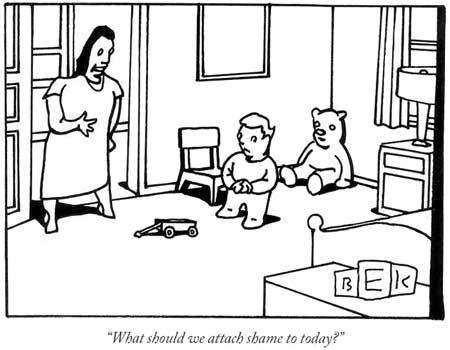
Attaching shame to our deepest conceptions of who we are is a common byproduct of the way that we humans are socialized. The expectations that are drummed into us from an early age are always with us and we never measure up. Just look at one of the central questions that has occupied human thinkers for centuries: "Are we really apes or are we creatures that carry the spark of the divine?". That's a pretty telling question. It says a lot about how good we humans believe we should be. If we aren't Gods we'd like to think that we at least have a special connection to one. The standards that we hold for ourselves can be pretty hard for anyone to live up to.
All of that might be just a little grandiose when we think about it. And it sets us up to believe that our true natures are somehow bad and unacceptable. As far as we know, we humans are the only creatures that are capable of actively loathing ourselves. To think that the mental illnesses aren't somehow related to that talent seems silly.
Mind models and machines
Our models of the mind are always intimately connected to the machines that are available in any given age. In Freud's day hydraulics were the big deal. So his model of the mind was essentially a hydraulic one. Various instinctual forces build up until the forces that oppose them are overrun. Symptoms occur as an interplay between the forces that are released and the abilities of the system to control them. Or something like that. There were a lot of breasts involved too.
Our brain models are now heavily influenced by our knowledge of computers. Both computers and genes run on similar binary, on-off systems. When we ask ourselves that age old question -"do mental disorders arise from nature or nurture?" - it's a lot like asking "which is more important, hardware or software?"
So the answer appears to be that anatomy is destiny. But only to a point. A super fast computer isn't much good when the only program you have available is a beat up game of PONG. And you can't the latest version of Madden NFL on an old Atari machine. Both the machine and the programs that we have to run on it have to match up well if something interesting is going to pop up on the screen.
The fact that our "hardware" is very much alive and changes itself dramatically in response to demands of the environment causes some problems with the computer analogy though. Plus, the content of our "software"- our beliefs, expectations, hopes, fears, talents and weaknesses all feed back to cause basic changes in the hardware too.
It's strange to think that many humans are intimidated by computers but never even consider the fact we have an apparatus of such far greater complexity right in our own skulls.
Future generations will certainly look back to view our present models of mental illness, including this one, as naïve and simplistic. Our models of the mind are always evolving and they can never offer more than a glimpse of something that is infinitely more wondrous and complex than the mind itself can ever comprehend.
All of our current treatment efforts will probably look primitive in hindsight. Some will even look barbaric. The ways that our society now cares for its brain disordered individuals will, hopefully, be recognized as misguided and ineffective. And perhaps the contributions of mentally ill people to our society will someday become respected.
People with mental illnesses ultimately provide us with enormous amounts of information about what it means to be a human being - information that wouldn't otherwise become apparent. They do this, of course, by demonstrating what happens when important brain systems are malformed or malfunctioning. But the lessons go beyond that. They also show us a great deal through the courage and dignity that so many bring to their struggle to create a decent life for themselves.
Seeing people with severe mental illnesses begin to recover can be truly inspirational. Watching them form loving relationships, show kindness towards each other, laugh together, work, play, demonstrate bravery and honesty, and find meaning in their lives makes us realize that there is hope for all of us.
How we - as a society and as individuals - understand and care for our mentally ill citizens also sheds light on this central question of what it really means to be human.